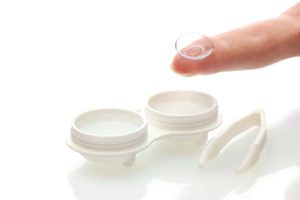
Keratoconus is a progressive eye disease that changes the shape of the normally round cornea. The disease causes the cornea to thin out and bulge into a cone-like shape, affecting vision. Some cases of keratoconus can be treated with contact lenses. However, there are limitations to this treatment option.
In this blog post, Mack Eye Center, a team of eye doctors in Hoffman Estates, discusses the disadvantages of treating keratoconus with contact lenses, as well alternative treatment options.
Treating Keratoconus with Contact Lenses
Standard soft contact lenses can be used to correct the nearsightedness and astigmatism caused by early stages of keratoconus. However, as the disease progresses, standard contact lenses may not be able to correct vision and can become uncomfortable to wear as the bulging of the cornea worsens. More advanced stages of the disease can be treated with rigid gas permeable (GP) contact lenses. GP lenses are harder than soft lenses and are able to vault over the cornea, replacing its cone-like shape with a smooth and more uniform refracting surface to improve vision.
The downside to treating keratoconus with GP lenses is that fitting the lenses can be difficult and time-consuming. Because lenses do not stop the progression of the disease, you will need to return to your eye doctor to receive a new prescription as the bulging of the cornea worsens. In addition, the ongoing bulging of the cornea can make it difficult and uncomfortable to wear lenses.
About Corneal Crosslinking and Intacs
Mack Eye Center offers Intacs for patients with more advanced stages of keratoconus or who simply do not want to wear contact lenses. Intacs are semi-circular corneal rings that are surgically implanted just under the eye’s surface to reshape the cornea for clearer vision. Intacs are comfortable to wear; you will not be able to feel the implants when they are in place and no one will be able to see them in your eye. What’s more, the procedure is completely reversible.
Mack Eye Center also offers collagen crosslinking (CXL), another minimally invasive procedure that uses a combination of vitamin B2 drops and ultraviolet light to strengthen collagen fiber bonding within the cornea and slow down the bulging of the cornea. Depending on the severity of your condition, you may still need to wear contact lenses even after undergoing collagen crosslinking. The good news, however, is that because collagen crosslinking strengthens and flattens the cornea, contact lens wear is much more comfortable.
The last option for treating keratoconus is corneal transplant surgery, which involves removing the bulging corneal tissue and replacing it with donor tissue. Thanks to advances in ophthalmology, surgical intervention is relatively rare these days.
The best treatment option for you will depend on several factors, including the severity of your condition. Our team at Mack Eye Center will recommend a treatment plan upon evaluating your eyes and condition.
To learn more about keratoconus treatment, please schedule a consultation with one of our board-certified ophthalmologists.

